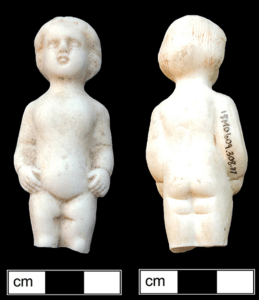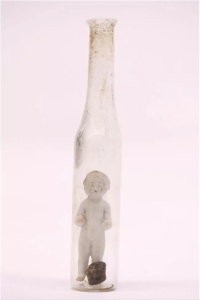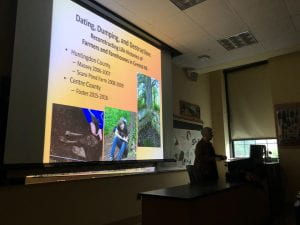 On November 2nd, Dr. Claire Milner, Emeritus Curator and Director of Exhibits at Penn State’s Matson Museum of Anthropology, joined us for her presentation, “Dating, Dumping, and Destruction: Reconstructing Life Histories of Farmers and Farmhouses in Central Pennsylvania.” She described three Penn State archaeological field schools she ran as project director at farmsteads in Central Pennsylvania. Two sites were excavated in Huntingdon County, the Massey site from 2006-2007 and the Scare Pond Farm from 2008-2009. She led excavations at the Foster site in Centre County from 2015-2016, as well.
On November 2nd, Dr. Claire Milner, Emeritus Curator and Director of Exhibits at Penn State’s Matson Museum of Anthropology, joined us for her presentation, “Dating, Dumping, and Destruction: Reconstructing Life Histories of Farmers and Farmhouses in Central Pennsylvania.” She described three Penn State archaeological field schools she ran as project director at farmsteads in Central Pennsylvania. Two sites were excavated in Huntingdon County, the Massey site from 2006-2007 and the Scare Pond Farm from 2008-2009. She led excavations at the Foster site in Centre County from 2015-2016, as well.

 Dr. Milner began by discussing why we should study farmhouses. Farmhouses are studied in historical archaeology as they can provide valuable informational contribution for the historical record and also address anthropological questions about human behavior. Farming has been and still is an extremely common way of life in the United States, and farmhouses are actually the most common type of archaeological site in the U.S. The 19th to early 20th centuries were a time of huge social and economic change, from industrialization and urban migration to innovations in agriculture and household technology. In Central Pennsylvania, lumbering and iron ore extraction, along with expansion of transportation and marketing networks were growing. However, today, the sites Dr. Milner studied are covered in trees and pastureland.
Dr. Milner began by discussing why we should study farmhouses. Farmhouses are studied in historical archaeology as they can provide valuable informational contribution for the historical record and also address anthropological questions about human behavior. Farming has been and still is an extremely common way of life in the United States, and farmhouses are actually the most common type of archaeological site in the U.S. The 19th to early 20th centuries were a time of huge social and economic change, from industrialization and urban migration to innovations in agriculture and household technology. In Central Pennsylvania, lumbering and iron ore extraction, along with expansion of transportation and marketing networks were growing. However, today, the sites Dr. Milner studied are covered in trees and pastureland.
 The Massey site was owned by the Massey family who were also owners of the Scare Pond Farm site. Thomas Massey emigrated from England to Chester County PA in 1683. He had children, and grandchildren, including Mordecai Massey (1747-1837). Mordecai had several children, including Daniel, who established agricultural societies at the state and local levels, and whose daughter Elizabeth would come to inherit the site in 1875 according to his will. In addition to documentary evidence of the family’s wealth and Daniels, from ventures such as co-owning a steel and whisky house, there was also a ‘fancy’ cemetery where Daniel and other family members were buried, with an iron railing around it that adds to the fact that this family had a good amount of money during their time. It is not clear when Daniel established his independent household, but it was most likely after his father’s death, sometime in the early 1840s. The main excavated house was built before 1875, most likely when Daniel started to pay taxes separately from his family, however, later ownership and occupancy is uncertain between the 1870s and 1930s when the state took over the property.
The Massey site was owned by the Massey family who were also owners of the Scare Pond Farm site. Thomas Massey emigrated from England to Chester County PA in 1683. He had children, and grandchildren, including Mordecai Massey (1747-1837). Mordecai had several children, including Daniel, who established agricultural societies at the state and local levels, and whose daughter Elizabeth would come to inherit the site in 1875 according to his will. In addition to documentary evidence of the family’s wealth and Daniels, from ventures such as co-owning a steel and whisky house, there was also a ‘fancy’ cemetery where Daniel and other family members were buried, with an iron railing around it that adds to the fact that this family had a good amount of money during their time. It is not clear when Daniel established his independent household, but it was most likely after his father’s death, sometime in the early 1840s. The main excavated house was built before 1875, most likely when Daniel started to pay taxes separately from his family, however, later ownership and occupancy is uncertain between the 1870s and 1930s when the state took over the property.
 Dr. Milner then went over discovered features and parts of the site that were excavated during her field schools at the Daniel Massey site. The site included a house, privy, garden, porch and patio. They located the north and east rooms of the house, along with a basement. A feature outside of the house was a garden with a barbed wire fence. The archaeologists noted the house layout based on a foundation collapsing into the basement. Trash would have been dumped out of the window area during the sites period of occupation, so based on a perimeter created by a midden, the location of a potential window was discovered. The entrance area of the house was determined to have a porch and patio; the front door was located based on piers of wood platforms into the door, and there was an indication of a brick patio, along with parts of porch pads and other remnants. Both a brick chimney and paved stone floor were also noted. A mystery wall Milner uncovered was eventually determined to be evidence of a rebuilding episode, as the house was T-shaped, buried above an L-shaped structure. There were also coins found inside and outside of this rebuilding, that gives great dates for when the rebuilding took place. Evidence of burnt wood in the basement suggests that a fire could have been the reason for the rebuilding. While a stone pad could have been interpreted as a pad for a staircase, it is unknown whether or not his house had a second floor. Other notable features include the Massey middens, and the Massey privy, a two-hole privy. There were a variety of dumping contexts and stratified deposits that may indicate a shift in dumping behavior and/or occupancy around
Dr. Milner then went over discovered features and parts of the site that were excavated during her field schools at the Daniel Massey site. The site included a house, privy, garden, porch and patio. They located the north and east rooms of the house, along with a basement. A feature outside of the house was a garden with a barbed wire fence. The archaeologists noted the house layout based on a foundation collapsing into the basement. Trash would have been dumped out of the window area during the sites period of occupation, so based on a perimeter created by a midden, the location of a potential window was discovered. The entrance area of the house was determined to have a porch and patio; the front door was located based on piers of wood platforms into the door, and there was an indication of a brick patio, along with parts of porch pads and other remnants. Both a brick chimney and paved stone floor were also noted. A mystery wall Milner uncovered was eventually determined to be evidence of a rebuilding episode, as the house was T-shaped, buried above an L-shaped structure. There were also coins found inside and outside of this rebuilding, that gives great dates for when the rebuilding took place. Evidence of burnt wood in the basement suggests that a fire could have been the reason for the rebuilding. While a stone pad could have been interpreted as a pad for a staircase, it is unknown whether or not his house had a second floor. Other notable features include the Massey middens, and the Massey privy, a two-hole privy. There were a variety of dumping contexts and stratified deposits that may indicate a shift in dumping behavior and/or occupancy around 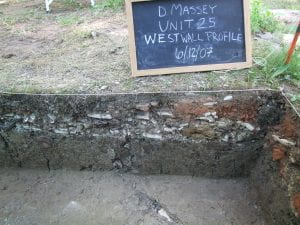 the house perimeter, the privy, and the area around and downslope from the privy (a possible upslope shift). After occupancy, there was some scavenging of construction materials such as the wood floor, and eventually the exterior of the house collapsed into the interior, as marked by unit profiles and materials in the basement. There was also some garbage dumping within the house after its collapse; found at shallow depths were artifacts such as broken medicine bottles and a scythe blade stuck in the corner of the house at an angle, not contemporaneous with the occupation.
the house perimeter, the privy, and the area around and downslope from the privy (a possible upslope shift). After occupancy, there was some scavenging of construction materials such as the wood floor, and eventually the exterior of the house collapsed into the interior, as marked by unit profiles and materials in the basement. There was also some garbage dumping within the house after its collapse; found at shallow depths were artifacts such as broken medicine bottles and a scythe blade stuck in the corner of the house at an angle, not contemporaneous with the occupation.
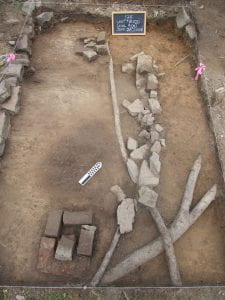
The Scare Pond Farm site was located on an extremely steep sloping ledge, an unusual place. This site included a house, barn, small outbuilding, and unknown building along the sharp sloping hill. It was also uncertain if any Massey’s had actually lived there. There was a spring nearby, but no evidence of a spring house, although a creek was further down slope from the house.

The previous occupants of the house had created lined pathways of stones and the archaeologists tested the barn on the bank, where they recovered a crock pot, and evidence of animals tamping down on the clay floor. They also tested an outbuilding foundation with a horseshoe in it, the foundation of the house itself, and the basement area. There was little found inside the basement; it was surmised that some bricks were from a collapsed chimney. Construction materials such as, a piece of cut wood from the floor and an upper stone tier, had been removed from the site, scavenged by someone. There were dumping features west of the house, one with a feature and one with a concentration of artifacts (stoneware). The recovered stoneware indicated garbage being dumped away from the house upslope. There were scattered stones next to the southeast house foundation wall that were full of mixed materials, which led to the discovery of two more rooms of the house. The walls of the rooms were constructed from whatever materials they could find, including brick and stone, and they could post-date the original foundation. A porch was evident from remnants of three stone pads in a line used as a base for the porch to hold it upright; the front of the porch was lined with stone. Marbles children would have played with were also recovered, most likely they had fallen off the porch. There were some confusing walls, and a mystery building with partly stratified deposits, that included a strangely angled wall, and sat on a slope. There was also a buried brick feature where the angled wall was, perhaps a buried patio. Stratigraphy indicated that there were multiple dumping episodes inside the building, leading to the supposition that animals were kept in one of the buildings on the site. Some features located included stoneware piping that suggested perhaps some type of plumbing was put in for the house during an expansion period. A surprise outside wall and a hitching post on one side of the house were also recovered. A clay layer inside and hitching post outside suggests the presence of animals. The fact that there were no level areas for cultivated fields also supports the idea that this site was perhaps occupied by a tenant of the Massey family who took care of animals.
 The Foster Farm was also excavated by Dr. Milner. This site was located on land owned by Penn State University, and by studying it, the researchers can provide information on the Arboretum history, explore 19th-20th century farm life, and compare with the Massey and Scare Pond Farm sites. Prior to Penn State’s ownership, records show that in 1791 an iron furnace was established by Miles & Patton, with timberland being converted into farms by the furnace owners, as well. The site went through a variety of owners throughout the centuries, records suggest that a tenant farmer was an occupant at the site for at least part of the time. The last owner was Charles Foster (1859-1934) who owned 120 acres, before the land became PSU pastureland in 1935. The Foster Farm landscape is made up of karstic limestone with well-drained fertile soil. However, there is no standing water nearby.
The Foster Farm was also excavated by Dr. Milner. This site was located on land owned by Penn State University, and by studying it, the researchers can provide information on the Arboretum history, explore 19th-20th century farm life, and compare with the Massey and Scare Pond Farm sites. Prior to Penn State’s ownership, records show that in 1791 an iron furnace was established by Miles & Patton, with timberland being converted into farms by the furnace owners, as well. The site went through a variety of owners throughout the centuries, records suggest that a tenant farmer was an occupant at the site for at least part of the time. The last owner was Charles Foster (1859-1934) who owned 120 acres, before the land became PSU pastureland in 1935. The Foster Farm landscape is made up of karstic limestone with well-drained fertile soil. However, there is no standing water nearby.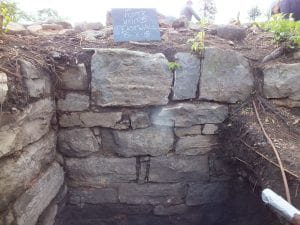
The site included a house, garden, possible cistern, porch, and standing outbuilding, and it had been heavily impacted by mowing. It was assumed that those who used to occupy the site were dependent on cistern water collection, as no other nearby water sources were present. A metal water pipe was found in the basement debris, but it could have possibly been deposited later. A basement foundation was also located, along with a rail line close to the site. Dr. Milner went on to discuss many features and describe parts of the site. There was a pit feature along the exterior of the west foundation wall that was perhaps a cistern. They found the house’s foundation interior, part of a chimney, evidence of a garden, the basement entrance, a west sloping dumping area, and on another side of the house an area of very mixed deposits, along with evidence of dumping around the house perimeter and the indication of a porch based on stacked stones, as well. There was little debris dumped inside the house, but a concentration of debris was along the perimeter, but this was not able to be excavated as it was close to the crumbling foundation wall. There were also areas of activity away from the house, but no discernable structures.
Data from the collection created from all three sites was then presented; artifact types and total counts found were discussed, which included a range of ceramics with a variety of decorative types, glass, metal, animal bones, nails, and other construction materials and debris. Less common artifacts present included smoking pipes, clothing like buttons and buckles, ammunition, pencil leads, coins, combs, musical instruments like a harmonica, toys, part of a pocket watch, and at Foster, a mantle clock part. Rarer but interesting finds included a backpin with the quote, “I’m a devil, give me a soda” found at the Massey site, an Irish pipe with a Home Rule harp design found at the Foster site, and also found at the Massey site were parts of an Admiral Dewy pitcher commemorating the 1898 Battle of Manila.
Dr. Milner then mentioned that by excavating these sites, there are many research opportunities provided. Researchers could delve into site occupation by trying to distinguish tenant versus owner occupancy, or research more on what activities occurred at each site over time. Interested parties could investigate what the objects and houses tell us about variation in human behavior, by measuring differences in wealth and status between occupations within or between sites or by studying differential access to markets and transportation in the Centre region. Researchers could also do intrasite and intersite chronology; determine the age of different occupations based primarily on historic records, and compare them to the archaeological record, or determine the relative chronology of buildings, strata, and rebuilding episodes within a site. Although, there are technical issues with it comes to making the artifact category counts comparable, given that they were excavated at different depths and to different extents. However, she is very interested and willing to work with students, and even have the collection brought to IUP if necessary. In the next few years, she has to finish with the projects and determine the collections fate. From dating projects based on the artifacts and documentary evidence, to research on the garbage dumping contexts and how these episodes relate to the occupations and destruction of the site, there are many opportunities for further research into these three sites.
Dr. Claire Milner’s presentation was extremely informative and educational! We cannot thank her enough for coming and speaking to us!
Follow IUP Anthropology on Facebook, Twitter, and Instagram
 Last weekend, March 9-12 was the Middle Atlantic Archaeological Conference held in Ocean City, Maryland. I was able to attend amazing sessions, panels, and student events and this was the first archaeology conference that I have presented at which was a great accomplishment as well. I arrived bright and early on Friday to attend a session on the Archaeology of Schools and Education in the Mid-Atlantic. This session included presentations on marbles and writing slates and how they can be analyzed to understand what students were learning and how they were learning it. There was also a brilliant presentation on the way we talk about Black schools and education. The presenter showed examples of exhibits and written reports that devalue black intelligence and education by not exploring what they were taught thoroughly and frankly being lazy when analyzing artifacts related to black schools.
Last weekend, March 9-12 was the Middle Atlantic Archaeological Conference held in Ocean City, Maryland. I was able to attend amazing sessions, panels, and student events and this was the first archaeology conference that I have presented at which was a great accomplishment as well. I arrived bright and early on Friday to attend a session on the Archaeology of Schools and Education in the Mid-Atlantic. This session included presentations on marbles and writing slates and how they can be analyzed to understand what students were learning and how they were learning it. There was also a brilliant presentation on the way we talk about Black schools and education. The presenter showed examples of exhibits and written reports that devalue black intelligence and education by not exploring what they were taught thoroughly and frankly being lazy when analyzing artifacts related to black schools. 


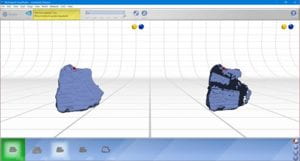


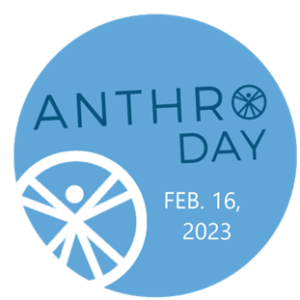
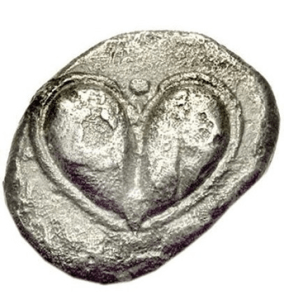




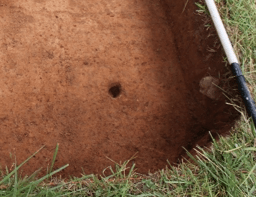



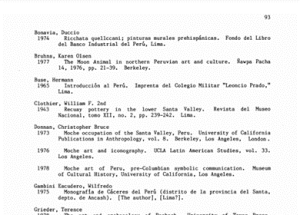
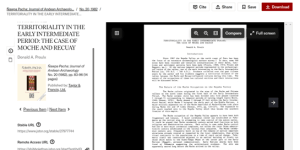


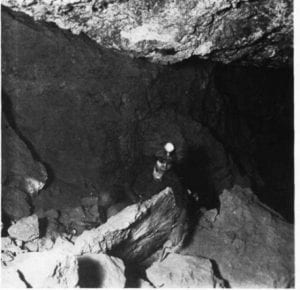


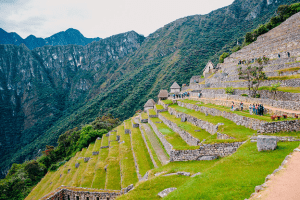
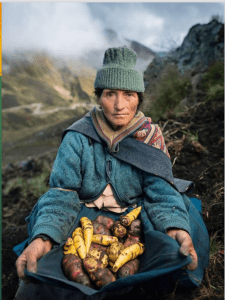
 On November 2nd, Dr. Claire Milner, Emeritus Curator and Director of Exhibits at Penn State’s Matson Museum of Anthropology, joined us for her presentation, “Dating, Dumping, and Destruction: Reconstructing Life Histories of Farmers and Farmhouses in Central Pennsylvania.” She described three Penn State archaeological field schools she ran as project director at farmsteads in Central Pennsylvania. Two sites were excavated in Huntingdon County, the Massey site from 2006-2007 and the Scare Pond Farm from 2008-2009. She led excavations at the Foster site in Centre County from 2015-2016, as well.
On November 2nd, Dr. Claire Milner, Emeritus Curator and Director of Exhibits at Penn State’s Matson Museum of Anthropology, joined us for her presentation, “Dating, Dumping, and Destruction: Reconstructing Life Histories of Farmers and Farmhouses in Central Pennsylvania.” She described three Penn State archaeological field schools she ran as project director at farmsteads in Central Pennsylvania. Two sites were excavated in Huntingdon County, the Massey site from 2006-2007 and the Scare Pond Farm from 2008-2009. She led excavations at the Foster site in Centre County from 2015-2016, as well.








